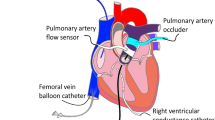Summary
The changes of mean outflow resistance (MOR) (defined as the ratio between mean aortic ejection pressure and mean ejection rate) and of total peripheral resistance (TPR) together with their relations to some circulatory parameters and to each other were studied under control (NaCl) and six different loading conditions on anesthetized closed chest dogs. Phenylephrine increased both MOR and TPR (ca. 160%, max), pacing increased MOR (p<0.01) but not TPR. Isoproterenol and dextran infusion decreased TPR (p<0.001) but not MOR. Calcium chloride decreased MOR (p<0.05) but increased TPR (NS). The relationship between MOR and TPR was linear in each case (r from 0.63 to 0.91). Both MOR and TPR showed either positive or negative linear correlations with volume and pressure parameters although MOR appeared to be more sensitive to the administered interventions. The present results suggest that, when referring to the pulsatile and discrete nature of the blood-flow-pressure output from the left ventricle, MOR seems to be a more useful measure than TPR in the assessment of the left ventricular afterload.
Similar content being viewed by others
References
Braunwald E, Sonnenblick EH, Ross J Jr (1980) Contraction of the normal heart. In: Braunwald E (ed) Heart disease. WB Saunders, Philadelphia, pp 413–452
Brutsaert DL, Paulus WJ (1977) Loading and performance of the heart as muscle and pump. Cardiovasc Res 11:1–16
Covell W, Pouleur H, Ross J Jr (1980) Left ventricular wall stress and aortic input impedance. Fed Proc 39:202–207
Elzinga G, Westerhof N (1978) The effect of an increase in inotropic state and end-diastolic volume on the pumping ability of the feline left heart. Circ Res 42:620–628
Elzinga G, Westerhof N (1979) How to quantify pump function of the heart. The value of variables derived from measurements on isolated muscle. Circ Res 44:303–308
Gessner U (1972) Vascular input impedance. In: Bergel DH (ed) Cardiovascular fluid dynamics, Vol 1, Academic Press, London, pp 315–349
Imperial ES, Levy MN, Zieske H Jr (1961) Outflow resistance as an independent determinant of cardiac performance. Circ Res 9:1148–1155
Kettunen R (1985) The thermodilution technique in on-line computation of the left ventricular volumes on anaesthetized dogs. Cathet Cardiovase Diagn 11:25–40
Milnor WR (1975) Arterial impedance as ventricular afterload. Circ Res 36:565–570
Noble MIM (1979) Left ventricular load, arterial impedance and their interrelationship. Cardiovasc Res 13:183–198
Okada M (1979) A digital filter for the QRS complex detection. IEEE Trans Biomed Engin BME 26:700–703
O'Rourke MF (1968) Impact pressure, lateral pressure, and impedance in the proximal aorta and pulmonary artery. J Appl Physiol 18:533–541
O'Rourke MF, Taylor MG (1967) Input impedance of the systemic circulation. Circ Res 20:365–380
Pouleur H, Covell JW, Ross J Jr (1979) Effects of alterations in aortic input impedance on the force-velocity-length relationship in the intact canine heart. Circ Res 45:126–135
Rumberger E, Bauman K (1982) Rate and phase dependence of outflow resistance of the heart. In: Kenner T, Busse R, Hinghofer-Szalkay H (eds) Cardiovascular System Dynamics: Models and Measurements. Plenum Press, New York, pp 169–174
Sagawa K (1981) The end-systolic pressure-volume relation of the ventricle: Definition, modifications and clinical use. Circulation 63:1223–1227
Sonnenblick EH, Downing SE (1963) Afterload as a primary determinant of ventricular performance. Am J Physiol 204:604–610
Strobeck JE, Sonnenblick EH (1981) Myocardial and ventricular function. Part II: Intact Heart. Herz 6:275–287
Timisjärvi J, Järvensivu P, Kettunen R (1984) Left ventricular responses to intravenous administration of clonidine in anaesthetized dogs. Acta Physiol Scand suppl 537:31–37
Wilcken DEL, Charlier AA, Hoffman JJE, Guz A (1964) Effects of alterations in aortic impedance on the performance of the ventricles. Circ Res 14:283–293
Yang SS, Bentivoglio LG, Maranhao V, Goldberg H (1978) Assessment of ventricular function. Systolic time intervals. In: Yang SS, Bentivoglio LG, Maranhao V, Goldberg H (eds) From cardiac catheterization data to hemodynamic parameters. Davis FA, Philadelphia, pp 257–261
Author information
Authors and Affiliations
Rights and permissions
About this article
Cite this article
Timisjärvi, J., Kettunen, R. & Rämö, P. Mean outflow resistance as a marker of left ventricular afterload. Basic Res Cardiol 82, 216–225 (1987). https://doi.org/10.1007/BF01906852
Received:
Issue Date:
DOI: https://doi.org/10.1007/BF01906852




